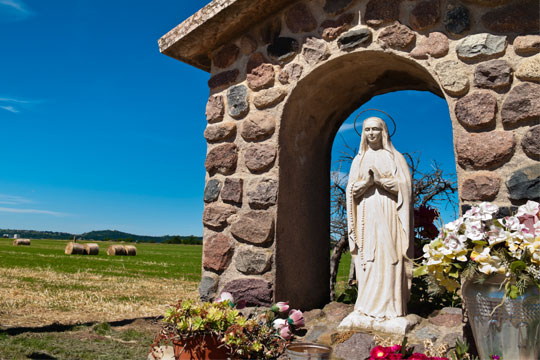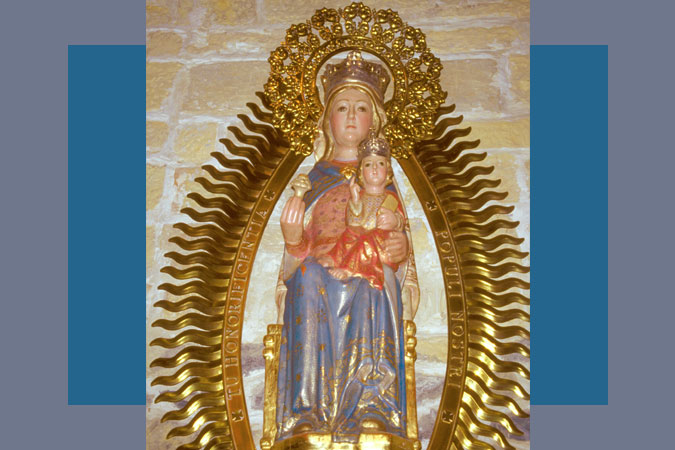
Welcome once more to our online retreat, the Spirituality of the Catechist. This week, we focus on the sixth aspect of a catechist’s spirituality: Devotion to the Blessed Virgin Mary.
If you’re just joining us, you can go back and catch up on earlier weeks at any time. If you haven’t already, share some thoughts about the retreat in the comments of any post in the series that inspires you in your vocation as a catechist.
Devotion to the Blessed Virgin Mary
In an issue of NCCL’s Catechetical Leader magazine (May/June 2009), Fr. Joseph Pellegrino points out that in artworks, Mary, the Mother of Jesus, is often holding up the child Jesus “for him to bless the world, to bless us.” He goes on to note that, “just as Mary was resolved to make God present in the world through her faith and obedience, as catechists, we are called to make God present to the world. We need to resolve to present Jesus, the Lord, to the world.”
That, in a nutshell, is why we catechists are called to have a devotion to Mary. We can imitate her in so many ways:
- When we were asked to be a catechist, our reaction was probably similar to Mary’s: “How can this be?” Like Mary, we may not consider ourselves worthy of such a calling. This humility is healthy. God does not call the qualified but qualifies the called. We can continually strive to say “yes” to God’s call to embody his Son Jesus and to bring him to others. And we do so with the humility that Mary showed: “Here am I, the servant of the Lord; let it be with me according to your word.” (Luke 1:38)
- As soon as Mary found out about her calling to be the Mother of Jesus, she moved into action. In Luke 1:38, the angel departs from her. In the very next verse, she sets out to visit her cousin Elizabeth! We can imitate Mary by eagerly moving into action (missionary zeal), bringing the Good News of Jesus Christ to others and stirring the life that is within them—as Mary’s greeting stirred the baby in Elizabeth’s womb.
- Several times in Scripture, we hear that Mary ponders things in her heart. She does so after the shepherds visit (Luke 2:19) and again after finding the child Jesus in the Temple (Luke 2:51). No doubt, Mary pondered many experiences in her heart throughout her life. We can imitate Mary by being contemplative in this same manner. When events happen in our lives, we can ponder them in our hearts, reviewing them to recognize more readily the hand of God in our lives. We can then teach our students to do the same.
- At the Wedding Feast at Cana, Mary plays a significant role in cooperating with the revelation of Jesus’ divinity. Traditionally, Christians have described the feast at Cana, along with the visit of the Magi and Jesus’ baptism in the Jordan as a three-fold epiphany, or revealing. Mary is intimately involved in two of these three events. At Cana, Mary prods Jesus to come to the aid of the hosts, who have run out of wine. She utters the last words recorded in Scripture that are attributed to her: “Do whatever he tells you.” (John 2:5) We can imitate Mary by making sure that our catechesis is always a revealing of Jesus’ true identity. We can also imitate Mary by telling those we teach to “do whatever he tells you.”
- Mary is at the foot of the Cross at the moment of her Son’s Death. She is part of what is known as the “Little Company of Mary”—the small band of faithful disciples who stood at the foot of the Cross throughout Jesus’ Suffering and Death. We can imitate Mary by being present to the suffering that is taking place in the lives of those we teach and in the community around us.
- The Acts of the Apostles (1:14) tells us that the early Christian community gathered united, with Mary in their company. In Acts 2:1, we hear that “when the day of Pentecost had come, they were all together in one place.” Christian tradition, therefore, places Mary at the coming of the Holy Spirit on Pentecost. Mary paid close attention to the promptings of the Holy Spirit throughout her life, and it makes perfect sense that on the day of Pentecost, she, with all the disciples of Jesus, was filled with the outpouring of the Holy Spirit in order to go forth and proclaim the Good News. We can imitate Mary by being Spirit-filled, by praying for the Gifts and Fruits of the Holy Spirit so that we may effectively proclaim the Good News.
- Finally, we can look to Mary’s Assumption as a sign of hope. When Mary’s time on earth was completed, she was assumed body and soul into heaven—a precursor, so to speak, of the Resurrection of the Body that all of us look forward to. Our ministry as catechists is grounded in hope. Mary’s Assumption is a sign of hope, a confident waiting for that day when we shall see God face to face, united body and soul, for all eternity.
Mary is, indeed, a “living catechism” and the “mother and model of catechists.” (Catechesi Tradendae)
Week Seven Reflection Questions

Over the next few days, ponder these reflection questions pertaining to this week’s theme. Then return here to Catechist’s Journey and share some of your reflections with your fellow retreatants.
- What story from the life of Mary do you treasure most? Why?
- What characteristic of Mary do you wish to imitate more closely?
- How does devotion to Mary bring you closer to Christ?
- What forms does your devotion to Mary take?
- What can you do in the days and weeks ahead to increase your devotion to Mary?
- Who is someone you know who has extraordinary devotion to Mary? How can you imitate him or her?
- Why do you think devotion to Mary is important for catechists?
- How can a deeper devotion to Mary impact the lives of those you teach?
Spiritual Exercises
During the course of this week, practice one or more of the following spiritual exercises designed to deepen your devotion to Mary. Share the fruits of your exercises with your fellow retreatants by posting your comments any time this week.
- Take to heart (memorize) the words of Mary’s Magnificat (the Canticle of Mary) found in Luke 1:46–55. Learn two verses each day, and at various times throughout the day, pray the verses that you have taken to heart, until, by the end of the week, you are able to recall this beautiful prayer by heart.
- Pray the Rosary each day this week for the intentions of all your fellow catechists who have journeyed through this retreat with you and for all those we teach.
- Learn to pray the Angelus, a prayer that celebrates the Incarnation of Jesus and Mary’s role in saying yes to God’s invitation (based on Luke 1:26–27). Catholics traditionally pray the Angelus at 6 a.m., noon, and 6 p.m.
Recommended Reading on the Topic of Devotion to the Blessed Virgin Mary
A Book of Marian Prayers by William G. Storey
The Little Office of Jesus and Mary by William G. Storey
Mary and the Saints: Companions on the Journey by James Campbell
Mary, the Compassionate Mother by Virgilio Elizondo
Mary: Jesus’ Mother—and Ours by Kevin Perrotta
Remember you can share your thoughts in the comments at any time. Come back on Thursday to read John Gonzalez’s reflection on our topic of devotion to Mary.




It is amazing that the life of Mary helps us to become closer to Jesus. She presented Him as we as cathecist should present Him. I loved the comparison and it helped me to become a better catechist.
Mary is a wonderful role model for catechists and those we teach. She lived a life of faith, hope and love giving us an example to follow. Throughout her life God was always first and she showed us how to do that in our own lives. She reminds us to always carry God to others in our everyday actions.
I am Raphaelmarymbauhar, from Nigeria, I am so happy to be here, for all this while that I am here I Learnt alout of things concerning my Faith as a Catholic